185 posts
Latest Posts by ocrim1967 - Page 6
Hot Jupiter
Planets in our own solar system have a wide range of properties. They are distinguished by two basic properties, their size and their orbit. The size determines if the planet can have a life-sustaining atmosphere. The orbit affects the surface temperature and whether there could be liquid water on the planet’s surface.
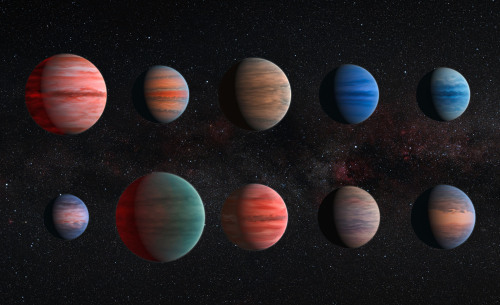
Hot Jupiters are a class of gas giant exoplanets that are inferred to be physically similar to Jupiter but that have very short orbital period (P<10 days). The close proximity to their stars and high surface-atmosphere temperatures resulted in the moniker “hot Jupiters”.

Hot Jupiters are the easiest extrasolar planets to detect via the radial-velocity method, because the oscillations they induce in their parent stars’ motion are relatively large and rapid compared to those of other known types of planets.

One of the best-known hot Jupiters is 51 Pegasi b. Discovered in 1995, it was the first extrasolar planet found orbiting a Sun-like star. 51 Pegasi b has an orbital period of about 4 days.

There are two general schools of thought regarding the origin of hot Jupiters: formation at a distance followed by inward migration and in-situ formation at the distances at which they’re currently observed. The prevalent view is migration.

Migration
In the migration hypothesis, a hot Jupiter forms beyond the frost line, from rock, ice, and gases via the core accretion method of planetary formation. The planet then migrates inwards to the star where it eventually forms a stable orbit. The planet may have migrated inwar.
In situ
Instead of being gas giants that migrated inward, in an alternate hypothesis the cores of the hot Jupiters began as more common super-Earths which accreted their gas envelopes at their current locations, becoming gas giants in situ. The super-Earths providing the cores in this hypothesis could have formed either in situ or at greater distances and have undergone migration before acquiring their gas envelopes.

source

Your Gut in Space
Finding the Right Balance for the Microbiota
Trillions of microorganisms live on and in the human body, many of them essential to its function and health. These organisms, collectively known as the microbiota, outnumber cells in the body by at least five times.

Microorganisms in the intestinal tract, the gut microbiota, play an especially important role in human health. An investigation on the International Space Station, Rodent Research-7 (RR-7), studies how the gut microbiota changes in response to spaceflight, and how that change in turn affects the immune system, metabolic system, and circadian or daily rhythms.

Research shows that the microbiota in the mammalian digestive tract has a major impact on an individual’s physiology and behavior. In humans, disruption of microbial communities has been linked to multiple health problems affecting intestinal, immune, mental and metabolic systems.

The investigation compares two different genetic strains of mice and two different durations of spaceflight. Twenty mice, ten of each strain, launch to the space station, and another 20 remain on the ground in identical conditions (except, of course, for the absence of gravity). Mice are a model organism that often serves as a scientific stand-in for other mammals and humans.

Fecal material collected from the mice every two weeks will be examined for changes in the gut microbiota. Researchers plan to analyze fecal and tissue samples after 30 and 90 days of flight to compare the effects of different durations of time in space.

With a better understanding of relationships between changes such as disruption in sleep and an imbalance of microbial populations, researchers can identify specific factors that contribute to changes in the microbiota. Further studies then can determine proactive measures and countermeasures to protect astronaut health during long-term missions.

Make sure to follow us on Tumblr for your regular dose of space: http://nasa.tumblr.com.





Saturn, Dione, Rhea, and Epimetheus & Saturn and Enceladus.
Credit: NASA/JPL-Caltech/SSI/CICLOPS/Kevin M. Gill
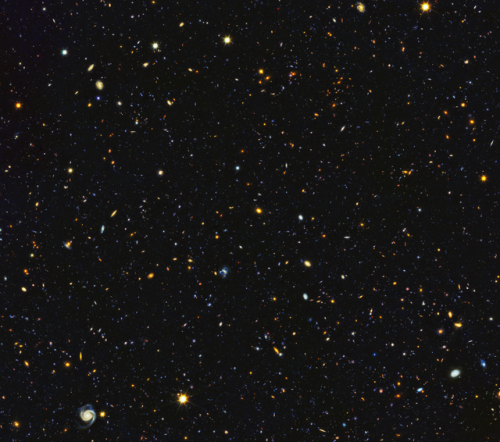
Astronomers have just assembled one of the most comprehensive portraits yet of the universe’s evolutionary history, based on a broad spectrum of observations by the Hubble Space Telescope and other space and ground-based telescopes. In particular, Hubble’s ultraviolet vision opens a new window on the evolving universe, tracking the birth of stars over the last 11 billion years back to the cosmos’ busiest star-forming period, about 3 billion years after the big bang. This photo encompasses a sea of approximately 15,000 galaxies — 12,000 of which are star-forming — widely distributed in time and space. This mosaic is 14 times the area of the Hubble Ultra Violet Ultra Deep Field released in 2014.
Credits: NASA, ESA, P. Oesch (University of Geneva), and M. Montes (University of New South Wales)








Observations of Earth, Soyuz, moon and Space Shuttle Endeavor made from the International Space Station.
source: images.nasa.gov
I was wondering if you could go in depth, at least to a degree about how incredibly dense objects have strong enough gravity to distort light. To me that's one of the wildest concepts I can imagine, not that I expect you to be all knowing but maybe you've got a good article or something? I don't recall if you've ever made posts about the theory of relativity. Sorry for the long ask!
Well, I know only the basics, things I study in my free time, however, I can try to explain. The distortion of space-time is described by Einstein’s Theory of General Reality. The more massive an object, the more its curvature will be in the space-time fabric.


This distortion in light is known as a gravitational lensing. The gravitational lensing is formed due to a space-time distortion caused by the presence of a large mass body between a distant light source and an observer.


These distortions are widely observed through globular clusters.
Since the amount of lensing depends on the total mass of the cluster, gravitational lensing can be used to ‘weigh’ clusters. This has considerably improved our understanding of the distribution of the ‘hidden’ dark matter in galaxy clusters and hence in the Universe as a whole. The effect of gravitational lensing also allowed a first step towards revealing the mystery of the dark energy.


As gravitational lenses function as magnification glasses it is possible to use them to study distant galaxies from the early Universe, which otherwise would be impossible to see.

Gravitational lensing happens on all scales – the gravitational field of galaxies and clusters of galaxies can lens light, but so can smaller objects such as stars and planets. Even the mass of our own bodies will lens light passing near us a tiny bit, although the effect is too small to ever measure.










Ask Ethan: Is Spacetime Really A Fabric?
“I’d like somebody to finally acknowledge and admit that showing balls on a bed sheet doesn’t cut it as a picture of reality.”
Okay, I admit it: visualizing General Relativity as balls on a bedsheet doesn’t make a whole lot of sense. For one, if this is what gravity is supposed to be, what pulls the balls “down” onto the bedsheet? For another, if space is three dimensional, why are we talking about a 2D “fabric” of space? And for another, why do these lines curve away from the mass, rather than towards it?
It’s true: this visualization of General Relativity is highly flawed. But, believe it or not, all visualizations of General Relativity inherently have similar flaws. The reason is that space itself is not an observable thing! In Einstein’s theory, General Relativity provides the link between the matter and energy in the Universe, which determines the geometric curvature of spacetime, and how the rest of the matter and energy in the Universe moves in response to that. In this Universe, we can only measure matter and energy, not space itself. We can visualize it how we like, but all visualizations are inherently flawed.
Come get the story of how to make as much sense as possible out of the Universe we actually have.
Mis conversaciones favoritas son aquellas que se tienen con el lápiz y el papel.
-Zufriedenheit.
Parker Solar Probe is Go for Launch
Tomorrow, Aug. 11, we’re launching a spacecraft to touch the Sun.

The first chance to launch Parker Solar Probe is 3:33 a.m. EDT on Aug. 11 from Space Launch Complex 37 at Cape Canaveral Air Force Station in Florida. Launch coverage on NASA TV starts at 3 a.m. EDT at nasa.gov/live.
After launch, Parker Solar Probe begins its daring journey to the Sun’s atmosphere, or corona, going closer to the Sun than any spacecraft in history and facing brutal heat and radiation.
Though Parker Solar Probe weighs a mere 1,400 pounds — pretty light for a spacecraft — it’s launching aboard one of the world’s most powerful rockets, a United Launch Alliance Delta IV Heavy with a third stage added.

Even though you might think the Sun’s massive means things would just fall into it, it’s surprisingly difficult to actually go there. Any object leaving Earth starts off traveling at about 67,000 miles per hour, same as Earth — and most of that is in a sideways direction, so you have to shed most of that sideways speed to make it to the Sun. All that means that it takes 55 times more launch energy to go to the Sun than it does to go to Mars. On top of its powerful launch vehicle, Parker Solar Probe will use seven Venus gravity assists to shed sideways speed.
Even though Parker Solar Probe will lose a lot of sideways speed, it’ll still be going incredibly fast as its orbit draws closer to the Sun throughout its seven-year mission. At its fastest, Parker Solar Probe will travel at 430,000 miles per hour — fast enough to get from Philadelphia to Washington, D.C. in one second — setting the record for the fastest spacecraft in history.

But the real challenge was to keep the spacecraft from frying once it got there.
We’ve always wanted to send a mission to the corona, but we literally haven’t had the technology that can protect a spacecraft and its instruments from its scorching heat. Only recent advances have enabled engineers to build a heat shield that will protect the spacecraft on this journey of extremes — a tricky feat that requires withstanding the Sun’s intense radiation on the front and staying cool at the back, so the spacecraft and instruments can work properly.

The 4.5-inches-thick heat shield is built like a sandwich. There’s a thin layer of carbon material like you might find in your golf clubs or tennis rackets, carbon foam, and then another thin piece of carbon-carbon on the back. Even while the Sun-facing side broils at 2,500 degrees Fahrenheit, the back of the shield will remain a balmy 85 degrees — just above room temperature. There are so few particles in this region that it’s a vacuum, so blocking the Sun’s radiation goes a long way towards keeping the spacecraft cool.
Parker Solar Probe is also our first mission to be named after a living individual: Dr. Eugene Parker, famed solar physicist who in 1958 first predicted the existence of the solar wind.

“Solar wind” is what Dr. Parker dubbed the stream of charged particles that flows constantly from the Sun, bathing Earth and our entire solar system in the Sun’s magnetic fields. Parker Solar Probe’s flight right through the corona allows it to observe the birth of the very solar wind that Dr. Parker predicted, right as it speeds up and over the speed of sound.

The corona is where solar material is heated to millions of degrees and where the most extreme eruptions on the Sun occur, like solar flares and coronal mass ejections, which fling particles out to space at incredible speeds near the speed of light. These explosions can also spark space weather storms near Earth that can endanger satellites and astronauts, disrupt radio communications and, at their most severe, trigger power outages.

Thanks to Parker Solar Probe’s landmark mission, solar scientists will be able to see the objects of their study up close and personal for the very first time.
Up until now, all of our studies of the corona have been remote — that is, taken from a distance, rather than at the mysterious region itself. Scientists have been very creative to glean as much as possible from their remote data, but there’s nothing like actually sending a probe to the corona to see what’s going on.

And scientists aren’t the only ones along for the adventure — Parker Solar Probe holds a microchip carrying the names of more than 1.1 million people who signed up to send their name to the Sun. This summer, these names and 1,400 pounds of science equipment begin their journey to the center of our solar system.
Three months later in November 2018, Parker Solar Probe makes its first close approach to the Sun, and in December, it will send back the data. The corona is one of the last places in the solar system where no spacecraft has visited before; each observation Parker Solar Probe makes is a potential discovery.
Stay tuned — Parker Solar Probe is about to take flight.
Keep up with the latest on the mission at nasa.gov/solarprobe or follow us on Twitter and Facebook.
Make sure to follow us on Tumblr for your regular dose of space: http://nasa.tumblr.com.





Read Full Article Here: 6 Tricks to Staying Positive - Psych2Go
Follow @psych2go for more




Ψ ♥ For more interesting psychology posts like this, follow @mypsychology ♥ Ψ
10 Things: How to Photograph a Meteor Shower
Taking photographs of a meteor shower can be an exercise in patience as meteors streak across the sky quickly and unannounced, but with these tips – and some good fortune – you might be rewarded with a great photo.
These tips are meant for a DSLR or mirrorless camera, but some point-and-shoot cameras with manual controls could be used as well.
1. The Photo Op: Perseids Meteors
The Perseids are dusty remnants of comet 109P/Swift-Tuttle.
Earth passes through the comet’s invisible, multi-billion mile trail of tiny debris each year around August, creating a meteor shower of so-called “shooting stars” as the particles are vaporized in our atmosphere.
Perseid meteors already are streaking across the sky. This year’s shower peaks on a moonless summer night -from 4 pm on the 12th until 4 am on the 13th Eastern Daylight Time.
Read more on the Perseids ›
2. Get away from city lights and find a place with dark skies.

In this 30 second exposure, a meteor streaks across the sky in Spruce Knob, West Virginia, during the 2016 Perseids meteor shower. Credit: NASA/Bill Ingalls
Too much light and it will be hard for your eyes to see fainter meteors, plus your image will get flooded with the glow of light. Turning down the brightness of the camera’s LCD screen will help keep your eyes adjusted to the dark. The peak of the 2018 Perseid meteor shower occurs just after the new moon, meaning a thin crescent will set long before the best viewing hours, leaving hopeful sky watchers with a moonlight-free sky!
3. Use a tripod.

In this ten-second exposure, a meteor streaks across the sky above Washington, DC during the 2015 Perseids meteor shower, Credit: NASA/Joel Kowsky
Meteor photography requires long exposures, and even the steadiest of hands can’t hold a camera still enough for a clear shot. Heavier tripods help reduce shaking caused by wind and footsteps, but even a lightweight tripod will do. You can always place sandbags against the feet of the tripod to add weight and stability. If you don’t have a tripod, you might be able to prop your camera on or up against something around you, but be sure to secure your camera.
4. Use a wide-angle lens.

In this 30 second exposure taken with a circular fish-eye lens, a meteor streaks across the sky during the 2016 Perseids meteor shower as a photographer wipes moisture from the camera lens Friday, August 12, 2016 in Spruce Knob, West Virginia. Credit: NASA/Bill Ingalls
A wide-angle lens will capture more of the sky and give you a greater chance of capturing a meteor in your shot, while a zoom lens captures a smaller area of the sky. The odds of a meteor streaking past that small patch are lower.
5. Use a shutter release cable or the camera’s built-in timer.

Long exposures are not just for meteors. In this shot taken at Joshua Tree National Park, a hiker’s headlamp leaves a trail of light along a twilight path. Credit: National Park Service / Hannah Schwalbe
A tripod does a great job of reducing most of the shaking your camera experiences, but even the act of pressing the shutter button can blur your extended exposure. Using the self-timer gives you several seconds for any shaking from pressing the shutter button to stop before the shutter is released. A shutter release cable (without a self-timer) eliminates the need to touch the camera at all. And if your camera has wifi capabilities, you might be able to activate the shutter from a mobile device.
6. Manually focus your lens.

In this 30 second exposure, a meteor streaks across the sky during the annual Perseids meteor shower Friday, August 12, 2016 in Spruce Knob, West Virginia. Credit: NASA/Bill Ingalls
At night, autofocus will struggle to find something on which to focus. Setting your focus to infinity will get you close, but chances are you’ll have to take some test images and do some fine tuning. With your camera on a tripod, take a test image lasting a few seconds, then use the camera’s screen to review the image. Zoom in to a star to see how sharp your focus is. If the stars look like fuzzy blobs, make tiny adjustments to the focus and take another test image.
Repeat until you are happy with the result.
If your camera has a zoomable electronic viewfinder or live view option, you might be able to zoom to a star and focus without having to take a test image.
7. Aim your camera.

The Perseids appear to radiate from the constellation Perseus, visible in the northern sky soon after sunset this time of year.
Even though we don’t know when or where a single meteor will appear, we do know the general area from which they’ll originate.
Meteor showers get their name based on the point in the sky from which they appear to radiate. In the case of the Perseids, during their peak, they appear to come from the direction of the constellation Perseus in the northern sky.
8. Calculate your exposure time.

In this 20-second exposure, a meteor lights up the sky over the top of a mountain ridge near Park City, Utah. Even though this image was captured during the annual Perseid meteor shower, this “shooting star” is probably not one of the Perseid meteors, which originate from material left behind by Comet Swift-Tuttle. Instead, it’s likely one of the many bits of rock and dust that randomly fall into the atmosphere on any given night. Credit: NASA/Bill Dunford
As Earth rotates, the stars in the sky appear to move, and if your shutter is open long enough, you might capture some of that movement. If you want to avoid apparent star movement, you can follow the 500 Rule. Take 500 and divide it by the length in millimeters of your lens. The resulting number is the length of time in seconds that you can keep your shutter open before seeing star trails. For example, if you’re using a 20 mm lens, 25 seconds (500 divided by 20) is the longest you can set your exposure time before star trails start to show up in your images.
9. Experiment!

In this 30 second exposure photo, hikers find their way to the top of Spruce Knob in West Virginia to view the annual Perseids meteor shower, Friday, August 12, 2016. Credit: NASA/Bill Ingalls
Once you know the maximum exposure time, you can set your shutter priority to that length and let the camera calculate other settings for your first image. Depending on how the image turns out, you can manually adjust aperture (set it to a lower number if the image is too dark) and ISO (set it to a higher number if the image is too dark) to improve your next images. Changing only one setting at a time will give you a better understanding of how those changes affect your image.
10. Enjoy the show.

The crew of the International Space Station captured this Perseid meteor falling to Earth over China in 2011. Credit: NASA
With your camera settings adjusted, capturing that perfect photo is just a matter of time and luck. The highest rate of meteors visible per hour is in the hours after midnight and before dawn. Set up your camera next to a lounge chair or a blanket to witness the wonder of a meteor shower for yourself – and, with any luck, you’ll take home some envy-inducing shots, too!
Make sure to follow us on Tumblr for your regular dose of space: http://nasa.tumblr.com.
Black holes
A black hole is a region of spacetime exhibiting such strong gravitational effects that nothing—not even particles and electromagnetic radiation such as light—can escape from inside it. The theory of general relativity predicts that a sufficiently compact mass can deform spacetime to form a black hole. The boundary of the region from which no escape is possible is called the event horizon. Although the event horizon has an enormous effect on the fate and circumstances of an object crossing it, no locally detectable features appear to be observed. In many ways a black hole acts like an ideal black body, as it reflects no light.

The idea of a body so massive that even light could not escape was briefly proposed by astronomical pioneer and English clergyman John Michell in a letter published in November 1784. Michell’s simplistic calculations assumed that such a body might have the same density as the Sun, and concluded that such a body would form when a star’s diameter exceeds the Sun’s by a factor of 500, and the surface escape velocity exceeds the usual speed of light.

At the center of a black hole, as described by general relativity, lies a gravitational singularity, a region where the spacetime curvature becomes infinite. For a non-rotating black hole, this region takes the shape of a single point and for a rotating black hole, it is smeared out to form a ring singularity that lies in the plane of rotation. In both cases, the singular region has zero volume. It can also be shown that the singular region contains all the mass of the black hole solution. The singular region can thus be thought of as having infinite density.

How Do Black Holes Form?
Scientists think the smallest black holes formed when the universe began.
Stellar black holes are made when the center of a very big star falls in upon itself, or collapses. When this happens, it causes a supernova. A supernova is an exploding star that blasts part of the star into space.

Scientists think supermassive black holes were made at the same time as the galaxy they are in.
Supermassive black holes, which can have a mass equivalent to billions of suns, likely exist in the centers of most galaxies, including our own galaxy, the Milky Way. We don’t know exactly how supermassive black holes form, but it’s likely that they’re a byproduct of galaxy formation. Because of their location in the centers of galaxies, close to many tightly packed stars and gas clouds, supermassive black holes continue to grow on a steady diet of matter.

If Black Holes Are “Black,” How Do Scientists Know They Are There?
A black hole can not be seen because strong gravity pulls all of the light into the middle of the black hole. But scientists can see how the strong gravity affects the stars and gas around the black hole.
Scientists can study stars to find out if they are flying around, or orbiting, a black hole.

When a black hole and a star are close together, high-energy light is made. This kind of light can not be seen with human eyes. Scientists use satellites and telescopes in space to see the high-energy light.

On 11 February 2016, the LIGO collaboration announced the first observation of gravitational waves; because these waves were generated from a black hole merger it was the first ever direct detection of a binary black hole merger. On 15 June 2016, a second detection of a gravitational wave event from colliding black holes was announced.

Simulation of gravitational lensing by a black hole, which distorts the image of a galaxy in the background
Animated simulation of gravitational lensing caused by a black hole going past a background galaxy. A secondary image of the galaxy can be seen within the black hole Einstein ring on the opposite direction of that of the galaxy. The secondary image grows (remaining within the Einstein ring) as the primary image approaches the black hole. The surface brightness of the two images remains constant, but their angular size varies, hence producing an amplification of the galaxy luminosity as seen from a distant observer. The maximum amplification occurs when the background galaxy (or in the present case a bright part of it) is exactly behind the black hole.
Could a Black Hole Destroy Earth?
Black holes do not go around in space eating stars, moons and planets. Earth will not fall into a black hole because no black hole is close enough to the solar system for Earth to do that.

Even if a black hole the same mass as the sun were to take the place of the sun, Earth still would not fall in. The black hole would have the same gravity as the sun. Earth and the other planets would orbit the black hole as they orbit the sun now.
The sun will never turn into a black hole. The sun is not a big enough star to make a black hole.
More posts about black holes
Source 1, 2 & 3





Read Full Article Here: 5 Effects of Physical Discipline - Psych2Go
Follow @psych2go for more!

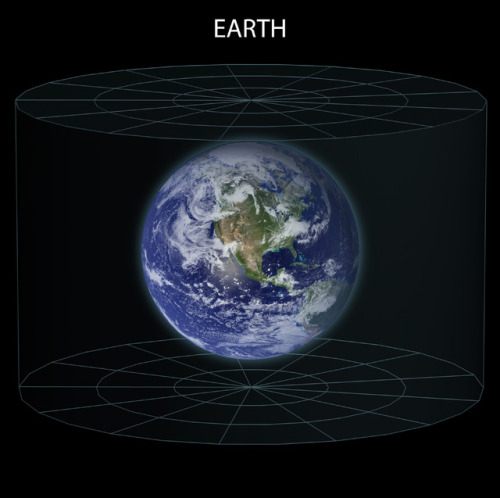
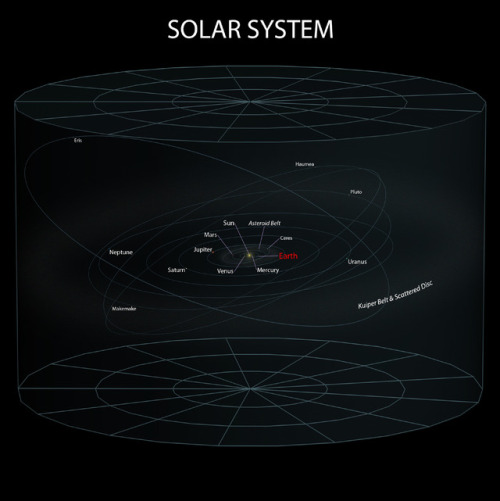
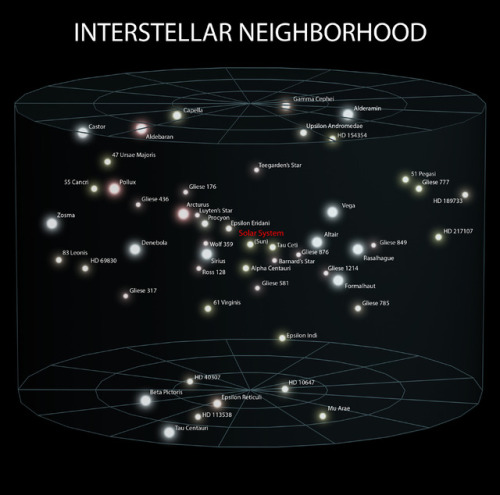

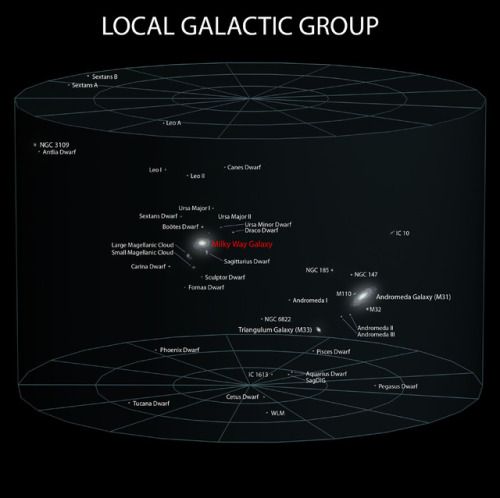
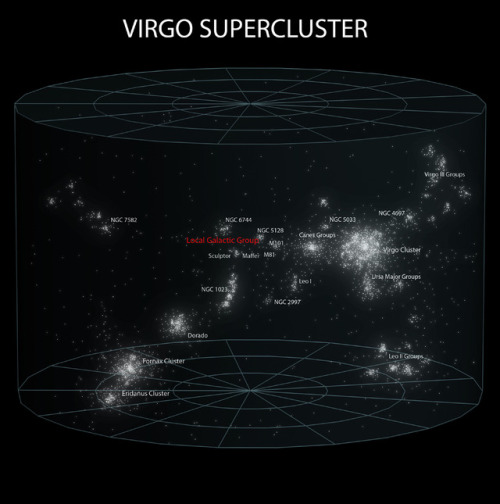
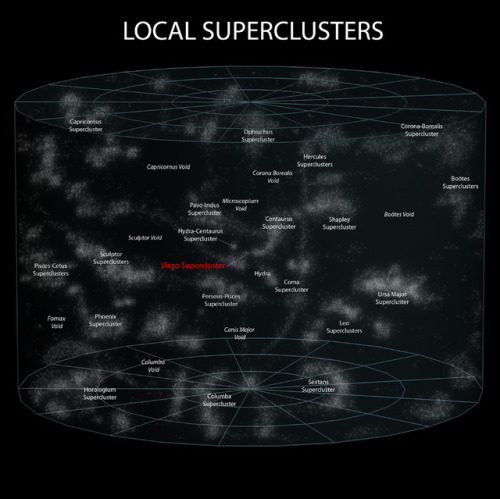
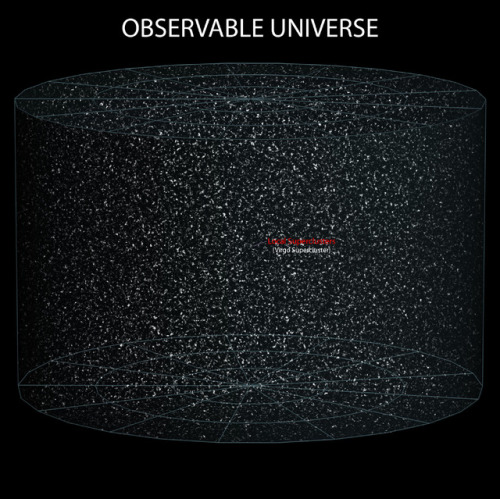
~ wikimedia commons








Psalm 19-1-4
Using All of Our Senses in Space
Today, we and the National Science Foundation (NSF) announced the detection of light and a high-energy cosmic particle that both came from near a black hole billions of trillions of miles from Earth. This discovery is a big step forward in the field of multimessenger astronomy.
But wait — what is multimessenger astronomy? And why is it a big deal?
People learn about different objects through their senses: sight, touch, taste, hearing and smell. Similarly, multimessenger astronomy allows us to study the same astronomical object or event through a variety of “messengers,” which include light of all wavelengths, cosmic ray particles, gravitational waves, and neutrinos — speedy tiny particles that weigh almost nothing and rarely interact with anything. By receiving and combining different pieces of information from these different messengers, we can learn much more about these objects and events than we would from just one.

Lights, Detector, Action!
Much of what we know about the universe comes just from different wavelengths of light. We study the rotations of galaxies through radio waves and visible light, investigate the eating habits of black holes through X-rays and gamma rays, and peer into dusty star-forming regions through infrared light.

The Fermi Gamma-ray Space Telescope, which recently turned 10, studies the universe by detecting gamma rays — the highest-energy form of light. This allows us to investigate some of the most extreme objects in the universe.

Last fall, Fermi was involved in another multimessenger finding — the very first detection of light and gravitational waves from the same source, two merging neutron stars. In that instance, light and gravitational waves were the messengers that gave us a better understanding of the neutron stars and their explosive merger into a black hole.

Fermi has also advanced our understanding of blazars, which are galaxies with supermassive black holes at their centers. Black holes are famous for drawing material into them. But with blazars, some material near the black hole shoots outward in a pair of fast-moving jets. With blazars, one of those jets points directly at us!
Multimessenger Astronomy is Cool

Today’s announcement combines another pair of messengers. The IceCube Neutrino Observatory lies a mile under the ice in Antarctica and uses the ice itself to detect neutrinos. When IceCube caught a super-high-energy neutrino and traced its origin to a specific area of the sky, they alerted the astronomical community.
Fermi completes a scan of the entire sky about every three hours, monitoring thousands of blazars among all the bright gamma-ray sources it sees. For months it had observed a blazar producing more gamma rays than usual. Flaring is a common characteristic in blazars, so this did not attract special attention. But when the alert from IceCube came through about a neutrino coming from that same patch of sky, and the Fermi data were analyzed, this flare became a big deal!

IceCube, Fermi, and followup observations all link this neutrino to a blazar called TXS 0506+056. This event connects a neutrino to a supermassive black hole for the very first time.

Why is this such a big deal? And why haven’t we done it before? Detecting a neutrino is hard since it doesn’t interact easily with matter and can travel unaffected great distances through the universe. Neutrinos are passing through you right now and you can’t even feel a thing!
The neat thing about this discovery — and multimessenger astronomy in general — is how much more we can learn by combining observations. This blazar/neutrino connection, for example, tells us that it was protons being accelerated by the blazar’s jet. Our study of blazars, neutrinos, and other objects and events in the universe will continue with many more exciting multimessenger discoveries to come in the future.
Want to know more? Read the story HERE.
Make sure to follow us on Tumblr for your regular dose of space: http://nasa.tumblr.com


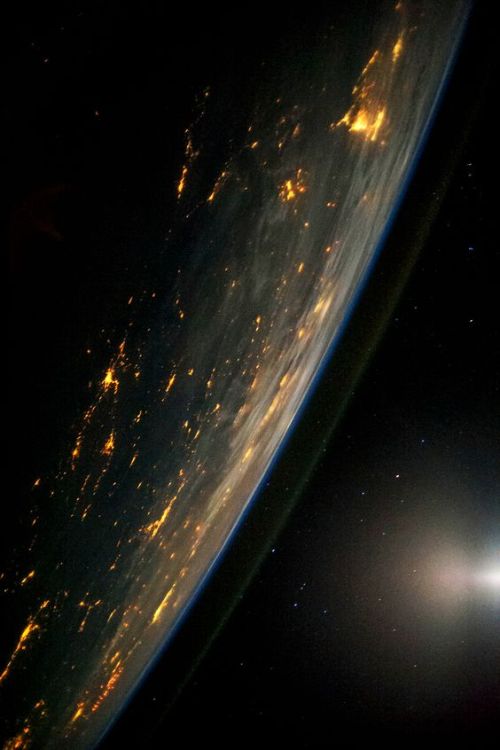
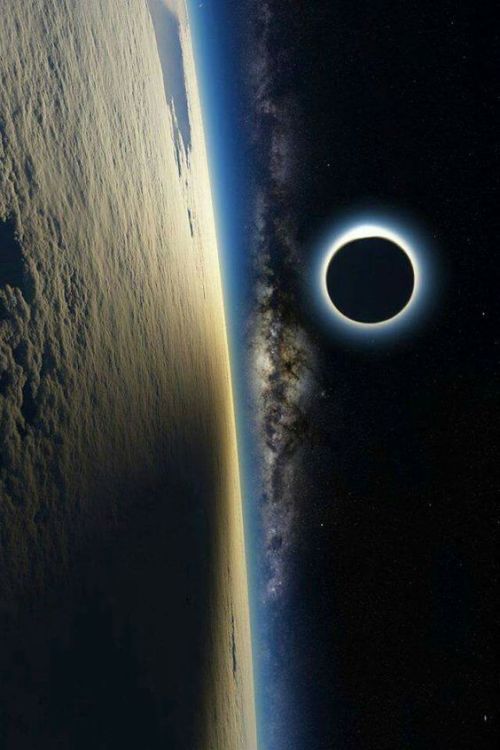



The galaxy is perfect










FOR SALE: Mobile &Web Illustration










It’s International Asteroid Day!
(Large Asteroid Impact Simulation)
Asteroid Day (also known as International Asteroid Day) is an annual global event that aims to raise awareness about asteroids and what can be done to protect the Earth, its families, communities, and future generations. Asteroid Day is held on the anniversary of the June 30, 1908 Siberian Tunguska event, the most harmful known asteroid-related event on Earth in recent history.
Learn more here
Animation



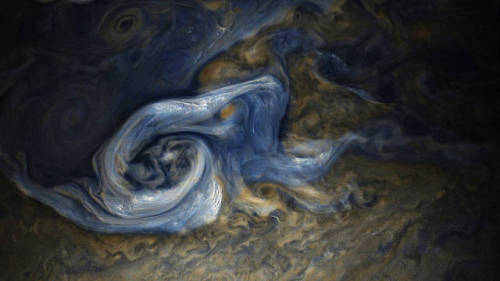
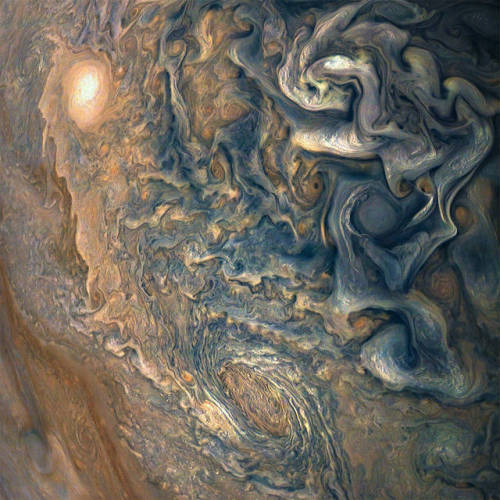
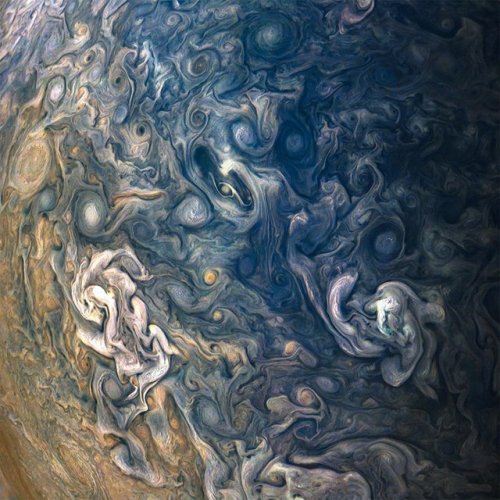
Swirls of Jupiter
Jupiter is a very stormy, turbulent, violent planet. The planet completes a day (or one complete rotation) within roughly 10 hours, which creates massive winds, producing these swirls, and violent storms. The fast rotation coupled with the fact that the planet is nothing but gas greatly multiplies the Coriolis effect. Earth too has a Coriolis effect, this creates the characteristic hurricane shapes and also contributes to the fact that storms will spin the opposite direction in different hemispheres. Luckily, our rotation is slower - our storms are less frequent and less violent than they would be if our days were shorter.
The above images come from the recent Juno mission by NASA.


Gif by Satiricon









ESO’s La Silla Observatory over the night sky
Image credit: ESO
What is an Exoplanet?
An exoplanet or extrasolar planet is a planet outside our solar system that orbits a star. The first evidence of an exoplanet was noted as early as 1917, but was not recognized as such. However, the first scientific detection of an exoplanet was in 1988. Shortly afterwards, the first confirmed detection was in 1992. As of 1 April 2018, there are 3,758 confirmed planets in 2,808 systems, with 627 systems having more than one planet.

The High Accuracy Radial Velocity Planet Searcher (HARPS, since 2004) has discovered about a hundred exoplanets while the Kepler space telescope (since 2009) has found more than two thousand. Kepler has also detected a few thousand candidate planets, of which about 11% may be false positives.

In several cases, multiple planets have been observed around a star. About 1 in 5 Sun-like stars have an “Earth-sized” planet in the habitable zone. Assuming there are 200 billion stars in the Milky Way, one can hypothesize that there are 11 billion potentially habitable Earth-sized planets in the Milky Way, rising to 40 billion if planets orbiting the numerous red dwarfs are included.

The least massive planet known is Draugr (also known as PSR B1257+12 A or PSR B1257+12 b), which is about twice the mass of the Moon. The most massive planet listed on the NASA Exoplanet Archive is HR 2562 b, about 30 times the mass of Jupiter, although according to some definitions of a planet, it is too massive to be a planet and may be a brown dwarf instead.

There are planets that are so near to their star that they take only a few hours to orbit and there are others so far away that they take thousands of years to orbit.

Some are so far out that it is difficult to tell whether they are gravitationally bound to the star. Almost all of the planets detected so far are within the Milky Way. Nonetheless, evidence suggests that extragalactic planets, exoplanets further away in galaxies beyond the local Milky Way galaxy, may exist. The nearest exoplanet is Proxima Centauri b, located 4.2 light-years (1.3 parsecs) from Earth and orbiting Proxima Centauri, the closest star to the Sun.

Besides exoplanets, there are also rogue planets, which do not orbit any star and which tend to be considered separately, especially if they are gas giants, in which case they are often counted, like WISE 0855−0714, as sub-brown dwarfs. The rogue planets in the Milky Way possibly number in the billions (or more).

Some planets orbit one member of a binary star system, and several circumbinary planets have been discovered which orbit around both members of binary star. A few planets in triple star systems are known and one in the quadruple system Kepler-64.

Methods of detecting exoplanets
1° Radial velocity
A star with a planet will move in its own small orbit in response to the planet’s gravity. This leads to variations in the speed with which the star moves toward or away from Earth, i.e. the variations are in the radial velocity of the star with respect to Earth. The radial velocity can be deduced from the displacement in the parent star’s spectral lines due to the Doppler effect. The radial-velocity method measures these variations in order to confirm the presence of the planet using the binary mass function.

2º Transit photometry
While the radial velocity method provides information about a planet’s mass, the photometric method can determine the planet’s radius. If a planet crosses (transits) in front of its parent star’s disk, then the observed visual brightness of the star drops by a small amount; depending on the relative sizes of the star and the planet.

3° Direct Imaging
Exoplanets are far away, and they are millions of times dimmer than the stars they orbit. So, unsurprisingly, taking pictures of them the same way you’d take pictures of, say Jupiter or Venus, is exceedingly hard.
New techniques and rapidly-advancing technology are making it happen.
The major problem astronomers face in trying to directly image exoplanets is that the stars they orbit are millions of times brighter than their planets. Any light reflected off of the planet or heat radiation from the planet itself is drowned out by the massive amounts of radiation coming from its host star. It’s like trying to find a flea in a lightbulb, or a firefly flitting around a spotlight.

On a bright day, you might use a pair of sunglasses, or a car’s sun visor, or maybe just your hand to block the glare of the sun so that you can see other things.
This is the same principle behind the instruments designed to directly image exoplanets. They use various techniques to block out the light of stars that might have planets orbiting them. Once the glare of the star is reduced, they can get a better look at objects around the star that might be exoplanets.
4° Gravitational Microlensing
Gravitational microlensing occurs when the gravitational field of a star acts like a lens, magnifying the light of a distant background star. This effect occurs only when the two stars are almost exactly aligned. Lensing events are brief, lasting for weeks or days, as the two stars and Earth are all moving relative to each other. More than a thousand such events have been observed over the past ten years.

If the foreground lensing star has a planet, then that planet’s own gravitational field can make a detectable contribution to the lensing effect. Since that requires a highly improbable alignment, a very large number of distant stars must be continuously monitored in order to detect planetary microlensing contributions at a reasonable rate. This method is most fruitful for planets between Earth and the center of the galaxy, as the galactic center provides a large number of background stars.
5° Astrometry
This method consists of precisely measuring a star’s position in the sky, and observing how that position changes over time. Originally, this was done visually, with hand-written records. By the end of the 19th century, this method used photographic plates, greatly improving the accuracy of the measurements as well as creating a data archive. If a star has a planet, then the gravitational influence of the planet will cause the star itself to move in a tiny circular or elliptical orbit.

Effectively, star and planet each orbit around their mutual centre of mass (barycenter), as explained by solutions to the two-body problem. Since the star is much more massive, its orbit will be much smaller. Frequently, the mutual centre of mass will lie within the radius of the larger body. Consequently, it is easier to find planets around low-mass stars, especially brown dwarfs.
source
source (+ Methods of detecting exoplanets)
source
images: NASA/ESA, ESO
animations: x, x, x, x, x
+ Exoplanets
Some intriguing exoplanets
What is Gravitational Lensing?
A gravitational lens is a distribution of matter (such as a cluster of galaxies) between a distant light source and an observer, that is capable of bending the light from the source as the light travels towards the observer. This effect is known as gravitational lensing, and the amount of bending is one of the predictions of Albert Einstein’s general theory of relativity.

This illustration shows how gravitational lensing works. The gravity of a large galaxy cluster is so strong, it bends, brightens and distorts the light of distant galaxies behind it. The scale has been greatly exaggerated; in reality, the distant galaxy is much further away and much smaller. Credit: NASA, ESA, L. Calcada
There are three classes of gravitational lensing:
1° Strong lensing: where there are easily visible distortions such as the formation of Einstein rings, arcs, and multiple images.

Einstein ring. credit: NASA/ESA&Hubble
2° Weak lensing: where the distortions of background sources are much smaller and can only be detected by analyzing large numbers of sources in a statistical way to find coherent distortions of only a few percent. The lensing shows up statistically as a preferred stretching of the background objects perpendicular to the direction to the centre of the lens. By measuring the shapes and orientations of large numbers of distant galaxies, their orientations can be averaged to measure the shear of the lensing field in any region. This, in turn, can be used to reconstruct the mass distribution in the area: in particular, the background distribution of dark matter can be reconstructed. Since galaxies are intrinsically elliptical and the weak gravitational lensing signal is small, a very large number of galaxies must be used in these surveys.

The effects of foreground galaxy cluster mass on background galaxy shapes. The upper left panel shows (projected onto the plane of the sky) the shapes of cluster members (in yellow) and background galaxies (in white), ignoring the effects of weak lensing. The lower right panel shows this same scenario, but includes the effects of lensing. The middle panel shows a 3-d representation of the positions of cluster and source galaxies, relative to the observer. Note that the background galaxies appear stretched tangentially around the cluster.
3° Microlensing: where no distortion in shape can be seen but the amount of light received from a background object changes in time. The lensing object may be stars in the Milky Way in one typical case, with the background source being stars in a remote galaxy, or, in another case, an even more distant quasar. The effect is small, such that (in the case of strong lensing) even a galaxy with a mass more than 100 billion times that of the Sun will produce multiple images separated by only a few arcseconds. Galaxy clusters can produce separations of several arcminutes. In both cases the galaxies and sources are quite distant, many hundreds of megaparsecs away from our Galaxy.
Gravitational lenses act equally on all kinds of electromagnetic radiation, not just visible light. Weak lensing effects are being studied for the cosmic microwave background as well as galaxy surveys. Strong lenses have been observed in radio and x-ray regimes as well. If a strong lens produces multiple images, there will be a relative time delay between two paths: that is, in one image the lensed object will be observed before the other image.

As an exoplanet passes in front of a more distant star, its gravity causes the trajectory of the starlight to bend, and in some cases results in a brief brightening of the background star as seen by a telescope. The artistic concept illustrates this effect. This phenomenon of gravitational microlensing enables scientists to search for exoplanets that are too distant and dark to detect any other way.Credits: NASA Ames/JPL-Caltech/T. Pyle
Explanation in terms of space–time curvature

Simulated gravitational lensing by black hole by: Earther
In general relativity, light follows the curvature of spacetime, hence when light passes around a massive object, it is bent. This means that the light from an object on the other side will be bent towards an observer’s eye, just like an ordinary lens. In General Relativity the speed of light depends on the gravitational potential (aka the metric) and this bending can be viewed as a consequence of the light traveling along a gradient in light speed. Light rays are the boundary between the future, the spacelike, and the past regions. The gravitational attraction can be viewed as the motion of undisturbed objects in a background curved geometry or alternatively as the response of objects to a force in a flat geometry.

A galaxy perfectly aligned with a supernova (supernova PS1-10afx) acts as a cosmic magnifying glass, making it appear 100 billion times more dazzling than our Sun. Image credit: Anupreeta More/Kavli IPMU.
To learn more, click here.
WHO IS HE?
In Genesis, He is the seed of the woman. In Exodus, He is the Passover Lamb. In Leviticus, He is our High Priest. In Numbers, He is pillar of cloud by day and a pillar of fire by night. In Deuteronomy, He is the prophet like unto Moses. In Joshua, He is the captain of our salvation. In Judges, He is our judge and lawgiver. In Ruth, He is our kinsman redeemer. In I and II Samuel, He is our trusted prophet. In Kings and Chronicles, He is our reigning king. In Erza, He is our faithful scribe. In Nehemiah, He is the rebuilder of the broken down walls of human life. In Ester, He is our Mordecai. In Job, He is our ever-living redeemer: “For I know my redeemer lives.” In Psalms, He is our shepherd. In Proverbs and Ecclesiastes, He is our wisdom. In Song of Solomon, He is the lover and the bridegroom. In Isaiah, He is the prince of peace. In Jeremiah, He is the righteous branch. In Lamentations, He is the weeping prophet. In Ezekiel, He is the wonderful four-faced man. In Daniel, He is the fourth man walking in the midst of the burning fiery furnaces of life. In Hosea, He is the husband forever married to the backslider. In Joel, He is the mighty baptizer in the Holy Ghost. In Amos, He is my burden bearer. In Obadiah, He is mighty to save. In Jonah, He is God’s great foreign missionary. In Micah, He is the messenger of beautiful feet. In Nahum, He is the avenger of God’s elect. In Habakkuk, He is God’s evangelist, crying, “Revive thy work in the midst of the years.” In Zephaniah, He is our Savior. In Haggai, He is the restorer of the lost heritage of Israel. In Zechariah, He is fountain opened up on the house of David for sin and uncleanness. In Malachi, He is the Son of Righteousness arisen with healing in His wings. In Matthew, He is the Messiah. In Mark, He is the wonder worker. In Luke, He is the Son of Man. In John, He is the Son of God. In Acts, He is the mighty baptizer in the Holy Ghost. In Romans, He is my justifier. In Corinthians, He is my sanctifier. In Galatians, He is the redeemer from the curse of the law. In Ephesians, He is the Christ of unsearchable riches. In Philippians, He is the God that supplies all my needs. In Colossians, He is the fullness of the godhead bodily. In I and II Thessalonians, He is my soon-coming King! In I and II Timothy, He is the mediator between God and man. In Tidus, He is my faithful pastor. In Philemon, He is the friend that sticketh closer than a brother. In Hebrews, He is the blood of the everlasting covenant. In James, He is our Great Physician, for “the prayer of faith shall save the sick.” In I and II Peter, He is my good shepherd. In I John, He is love. In II John, He is love. In III John, He is love. In Jude, He is the Lord coming with 10,000 of His saints. In Revelation, He is King of Kings and Lord of Lords.
HE IS THE WORD OF GOD.